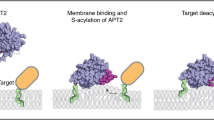Abstract
Palmitoylation (S-acylation) is the posttranslational attachment of fatty acids to cysteine residues and is common among integral and peripheral-membrane proteins. Palmitoylated proteins have been found in every eukaryotic cell type examined (yeast, insect, and vertebrate cells), as well as in viruses grown in these cells. Integral membrane proteins are palmitoylated at cysteine residues located at the boundary between the transmembrane segment and the cytoplasmic tail. Peripheral membrane proteins are often acylated at a N-terminal MGCXXS motif, which provides a dual signal for amide-myristoylation, as well as S-palmitoylation. However, comparison of the amino acids in the vicinity of all known palmitoylated cysteine residues reveals no obvious consensus signal for palmitoylation. Thus, palmitoylation of a protein cannot be predicted from its amino acid sequence. An enzyme responsible for the transfer of fatty acids (PAT) has not yet been purified, but several in vitro systems suggest that it is membrane-bound (1–5).
Access this chapter
Tax calculation will be finalised at checkout
Purchases are for personal use only
Similar content being viewed by others
References
Schmidt, M. F. G. and Burns, G. R. (1989) Solubilization of protein fatty acyltransferase from placental membranes and cell-free acyl transfer. Biochem. Soc. Trans. 17, 859,860.
McIlhinney, R. A. J. (1990) The fats of life: the importance and function of protein acylation. Trends Biochem. Sci. 15, 387–391.
James, G. and Olson, E. N. (1990) Fatty acylated proteins as components of intracellular signaling pathways. Biochemistry 29, 2623–2634.
Schlesinger, M. J., Veit, M., and Schmidt, M. F. G. (1993) Palmitoylation of viral and cellular proteins, in Lipid Modifications of Proteins (Schlesinger, M. J., ed.), CRC, Boca Raton, FL, pp. 1–19.
Bouvier, M., Moffett, S., Loisel, T. P., Mouillac, B., Hebert, T., and Chidiac, P. (1995) Palmitoylation of G-protein-coupled receptors: a dynamic modification with functional consequences. Biochem. Soc. Trans. 23, 116–120.
Davison, A. J. and Elliot, R. M., eds. (1993) Molecular Virology: A Practical Approach. IRL, Oxford, UK.
Berger, M. and Schmidt, M. F. G. (1984) Cell-free fatty acid acylation of Semliki Forest virus polypeptides with microsomal membranes from eukaryotic cells. J. Biol. Chem. 259, 7245–7252.
Veit, M., Herrler, G., Schmidt, M. F. G., Rott, R., and Klenk, H.-D. (1990) The hemagglutinating glycoproteins of influenza B and C viruses are acylated with different fatty acids. Virology 177, 807–811.
Muszbek, L. and Laposata, M. (1993) Covalent modification of proteins by arachidonate and eicosapentaenoate in platelets. J. Biol. Chem. 268, 18,243–18,248.
Milligan, G., Parenti, M., and Magee, A. I. (1995) The dynamic role of palmitoylation in signal transduction. Trends Biochem. Sci. 20, 181–187.
Wedegaertner, P. B., Wilson, P. T., and Bourne, H. R. (1995) Lipid modification of trimeric G-proteins. J. Biol. Chem. 270, 503–506.
Camp, L. A., Verkruyse, L. A., Afendis, S. J., Slaughter, C. A., and Hofman, S. L. (1994) Molecular cloning of a palmitoyl-protein thioesterase. J. Biol. Chem. 269, 23,212–23,219.
Veit, M., Kretzschmar, E., Kuroda, K., Garten, W., Schmidt, M. F. G., Klenk, H.-D., and Rott, R. (1991) Site-specific mutagenesis identifies three cysteine residues in the cytoplasmic tail as acylation sites of influenza virus hemagglutinin. J. Virol. 65, 2491–2500.
Resh, M. D. (1994) Myristylation and palmitylation of Src-family members: The fats of the matter. Cell 76, 411–413.
Walker, J. M., ed. (1984) Methods in Molecular Biology, vol. 1: Proteins. Humana, Clifton, NJ.
Casey, P. J. and Buss, J. E., eds. (1995) Methods in Enzymology, vol. 250: Lipid Modification of Proteins. Academic, San Diego.
Hooper, N. M. and Turner, A. J. eds. (1992) Lipid Modification of Proteins: A Practical Approach. IRL, Oxford, UK.
Kates, M., ed. (1986) Laboratory Techniques in Biochemistry and Molecular Biology: Techniques in Lipidology. Elsevier, Amsterdam.
Bizzozero, O. A. (1995) Chemical analysis of acylation sites and species, in Methods in Enzymology, vol. 250 (Casey, P. J. and Buss, J. E., eds.), Academic, San Diego, pp. 361–379.
Magee, A. I., Gutierrez, L., McKay, I. A., Marshall, C. J., and Hall, A. (1987) Dynamic fatty acylation of p21N-ras. EMBO J. 6, 3353–3357.
Schmidt, M. F. G. and Schlesinger, M. J. (1980) Relation of fatty acid attachment to the tranlation and maturation of vesicular stomatitis and Sindbis virus membrane glycoproteins. J. Biol. Chem. 255, 3334–3339.
Veit, M. and Schmidt, M. F. G. (1993) Timing of palmitoylation of influenza virus hemagglutinin. FEBS Lett. 336, 243–247.
Findlay, J. B. C. and Evans, W. H., eds. (1987) Biological Membranes: A Practical Approach. IRL, Oxford, UK.
McPherson, M. J., ed. (1991) Directed Mutagenesis: A Practical Approach. IRL, Oxford, UK.
Harlow, E. and Lane, D., eds. (1989) Antibodies: A Laboratory Manual. Cold Spring Harbor Laboratory, Cold Spring Harbor, NY.
Author information
Authors and Affiliations
Editor information
Editors and Affiliations
Rights and permissions
Copyright information
© 1998 Humana Press Inc.
About this protocol
Cite this protocol
Veit, M., Schmidt, M.F.G. (1998). Membrane Targeting via Protein Palmitoylation. In: Clegg, R.A. (eds) Protein Targeting Protocols. Methods in Molecular Biology™, vol 88. Humana Press. https://doi.org/10.1385/0-89603-487-9:227
Download citation
DOI: https://doi.org/10.1385/0-89603-487-9:227
Publisher Name: Humana Press
Print ISBN: 978-0-89603-487-7
Online ISBN: 978-1-59259-572-3
eBook Packages: Springer Protocols




